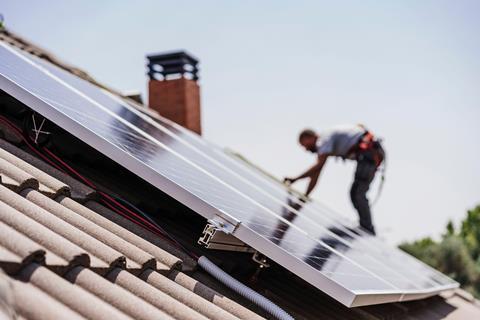From net zero developments to green leases, ‘ESG’ has become part of the lexicon of the commercial property lawyer. Maria Shahid reports
The low down
Pressure is mounting on building owners whose stock does not meet minimum energy efficiency standards. These standards, required for new lets, will soon apply to existing tenancies. The sky-high price of energy has also focused minds on consumption. Environmental concerns are being pushed to the top of the agenda for commercial property lawyers. Clients who are in a position to ‘future-proof’ their stock are doing so. But there are compliance exemptions for some landlords, and with small businesses in particular struggling in a stagnant economy, these are being exploited. There are fears of a two-tier property market emerging. Yet, what are the alternatives in this crucial area for a world facing a man-made climate emergency?
The UK built environment is responsible for 25% of the country’s greenhouse gas emissions. The sector is under increasing pressure to clean up its act. The government’s net zero strategy, published in 2021, set out a pathway to net zero by 2050. A series of industry roadmaps followed, including the UK Green Building Council’s (UKGBC) Whole Life Carbon Roadmap, launched at COP26 in November 2021.
The ongoing war in Ukraine, along with subsequent energy price rises have, if anything, increased the focus on renewables, say market experts. Europe wants to reduce its reliance on Russian gas and instead focus on cleaner energy sources such as solar and wind.
The tightening of energy efficiency regulations has also acted as a catalyst, with landlords left with no choice but to improve the green credentials of their buildings.
That is reflected in instructions. Property lawyers are advising on more green projects than ever before, whether they be renewable developments or buildings with net zero carbon. Alongside this, green lease clauses that allow for a better understanding of a building’s energy efficiency are becoming an industry standard.
‘The pandemic really galvanised the ESG [environmental, social and governance] agenda in the sector,’ says Charles Russell Speechlys partner Cara Imbrailo. ‘Green lease clauses and ESG weren’t really widely discussed before 2019/20… but Covid made it an absolute essential. Landlords are now really looking at their portfolios. They are asking, “what do I need to do to make sure we are taking this seriously?” ESG is there at every stage of the property life cycle.’
Jonathan Cohen, a renewable energy specialist at Howard Kennedy, notes that there has been an explosion in instructions relating to ESG over the last few years.
‘The ESG agenda in real estate is fast evolving and complex, and there are many occasions when our clients ask our advice when working on their ESG strategies,’ says Forsters partner Victoria Towers. ‘We act for a number of significant funds who often rely on our research and recommendations.’
Energy crisis
But has the energy price crisis caused property clients to put sustainability initiatives on hold as they seek to contain costs?
Cohen acknowledges that the extent to which sustainability is prioritised will depend on the size of the organisation, with smaller companies more likely to be focused on financial concerns. He says: ‘If you have a commercial decision to make in a smaller company, do you put the focus on ESG or on your business? With the cost of living crisis, I suspect the answer is quite clear.’
Rob Biddlecombe, an environment partner at Brabners, agrees that economic and geopolitical factors have shifted priorities. ‘It is absolutely the case that larger organisations will withstand the cost rises, it’s the smaller companies that will struggle,’ he says. ‘Nonetheless I do think it’s a false economy. It reminds me in some ways of the 2008 credit crunch. Organisations were more concerned with the immediate survival of their business than anything else. But these crises don’t last forever. If you take too short-term an approach, that comes with the risk that when that crisis dissipates you’re left at a commercial disadvantage to those who kept those longer-term concerns, such as ESG, at the front of their agenda.’
Biddlecombe adds: ‘Sustainability may have an initial capital outlay, but longer-term there are cost savings. In the fullness of time, I am sure this crisis will dissipate. That’s how I am advising my clients.’
EPC pressures
Upcoming changes to regulations, due to come into effect on 1 April, may also force change when it comes to improving the energy efficiency of buildings.
All buildings in the UK require an energy performance certificate (EPC). Currently, the minimum energy efficiency standards (MEES) require new lettings to have a minimum EPC rating of E (the highest rating is A). However, the MEES are due to be tightened in April, meaning that existing commercial lettings will also need to have a minimum EPC (energy performance certificate) rating of E.
‘I am getting more and more queries about this,’ says Biddlecombe. ‘It’s a severe penalty – up to £150,000 for failure to comply, which is a substantial amount of money, especially at the moment.’
Seddons partner Thomas White agrees that the EPC issue is going to gain traction over the coming months, with many of his clients in the commercial property sector checking if they have assets in their portfolio which have been caught by this change.
‘There are a number of competing factors,’ says Biddlecombe. ‘I am not aware of any enforcement notices being served to date. That may change post-1 April. Local authorities will need to carry out investigations to see if properties are compliant, which leaves the question of whether they have sufficient resources to do so.
‘We don’t know what the appetite from the enforcement authorities is going to be. Will they go for smaller enterprises or bigger fish? It wouldn’t surprise me if a big company gets targeted.’
'You don’t want to be the landlord that isn’t complying. Everyone, whatever their size, is being encouraged to look at their position'
Cara Imbrailo, Charles Russell Speechlys
While the MEES were first implemented in 2018, from April the regulations will make it unlawful for a landlord to ‘continue to let’ unless suitable energy efficiency improvements have been made, or there is an applicable exemption.
‘From a practitioner’s point of view, that is the biggest change. Prior to this, the MEES were only relevant when granting a new lease,’ says White. The problems arise when you have sitting tenants, he adds. ‘It’s difficult to interrupt a tenant’s business to ensure the premises are meeting the EPC rating.’
The exemptions may still present landlords with a ‘get out of jail free’ card, says Fieldfisher partner Rhodri Pazzi-Axworthy: ‘The exemptions include where the landlord needs third-party consent to do the work necessary to improve the building’s energy efficiency [and this is] either withheld or issued subject to conditions with which the landlord cannot reasonably comply.’
Pazzi-Axworthy gives an example: ‘We’ve got a client that lets a hotel to a large accommodation chain. When their tenant fitted out the property, they put electric heaters in every room and that keeps the EPC rating low. The best way to significantly increase the rating for that building is by ripping out all the heaters and replacing them with a new efficient centralised heating system. But because it’s all part of the tenant’s fit-out, unless our client agrees with the tenant to redo the heating system – which the tenant will probably refuse to pay for – then our client won’t have the necessary third-party consent it needs to do the works.’

He adds that the exemptions are not an indefinite ‘free pass’ but do buy the landlord some time ‘to plan its strategy going forward’.
Most lawyers, nonetheless, are telling clients to take the changes seriously. White says: ‘From an advice perspective, we are telling clients that they need to be aware of this change. In addition to the fines, there is also the reputational issue.’
‘I suspect clients will be coming to us, with the 1 April deadline looming,’ says Imbrailo. ‘They will be looking at their whole portfolio and thinking about what they need to do to get it up to standard.’
She also notes that reputation is key: ‘You don’t want to be the landlord that isn’t complying. Everyone, whatever their size, is being encouraged to look at their position. I suspect everyone will face some scrutiny.’
Clyde & Co partner Will Deeprose confirms that the ‘reputational concern is far greater than the financial concern of being fined’.
‘What a lot of people might not understand is that the standards are only ratcheting up over the coming years,’ warns Clyde & Co partner Laura Oliver. ‘Our clients are, on the whole, very sophisticated and have known that this is coming down the track.’
As of 2025, all newly rented commercial and residential properties will be required to have a minimum EPC rating of C; this will be extended to existing tenancies in 2028. By 2030 the MEES are set to tighten further, with a minimum requirement of B by 2030, with an interim milestone of C in 2027.
Imbrailo says: ‘We are encouraging [clients] to take a long-term view. Where possible don’t just do what’s necessary.’
Showing your carbon credentials
Rocketing energy prices, alongside their own net zero ambitions and tightening EPC standards, mean developers and other property owners are increasingly looking at the ‘operational carbon’ of a building when developing sites (ie emissions once it is in use). In many cases, this means incorporating renewables as well as other energy efficiency measures.
‘Energy efficiency and a switch to renewables will play a central role in the decarbonisation journey,’ notes Forsters partner Victoria Towers. ‘This can range from the transition of urban or rural land to wind or solar farms, through to the roll-out of electric vehicle-charging points across a range of real estate asset classes.’

It has also led to a range of instructions for lawyers. ‘We are seeing an increasing appetite for traditional “property” clients to work collaboratively with energy developers to put together a green offering for tenants,’ says Burges Salmon partner Ross Polkinghorne. ‘This is often rooftop solar, onsite generation and storage, direct wire supply or a combination of these.’
Howard Kennedy has been working with a joint venture which is developing the largest battery storage development in the UK. ‘It’s a really lucrative market for them,’ notes Howard Kennedy partner Jonathan Cohen. ‘There are a lot of new market participants. Supply issues with batteries and wider macroeconomic issues mean that they can monetise these assets.’
Clyde & Co is working on a new development at London’s South Bank: ‘We have been acting on a building at Bankside Yards, SE1, which is the UK’s first fossil-fuel-free major mixed-used development, which will be carbon neutral in operation,’ notes Clyde & Co partner Will Deeprose. ‘There has been a lot of interest in the building because of its carbon credentials.’
Avoiding obsolescence
While new developments incorporate sustainability through energy efficiency at the design stage, improving existing buildings is a major challenge. The biggest hurdle for the sector is retrofitting this stock to avoid obsolescence.
Cohen says: ‘Our clients are looking to future-proof their assets so that they are not obsolete. They want to make sure that they are fit for the future.’
The UKGBC last year published a guide calling on businesses to retrofit the country’s poorly performing commercial buildings. It notes that from 2025, every commercial building in the UK will require an energy performance certificate, which rates its energy efficiency from grade A to G.
'Significant sums of money will need to be spent if we are going to get to where the government says it wants to be by 2030'
Rhodri Pazzi-Axworthy, Fieldfisher
‘From an ESG perspective the case for retrofitting is clear when you look at the “whole life” carbon,’ says Imbrailo. That means taking account not just of the building’s ‘operational carbon’, but the carbon used in its construction materials – its ‘embodied carbon’. Though she acknowledges this is a nuanced discussion that will depend very much on the building in question.
‘About 80% of today’s commercial property stock will still exist in 2050, so retrofitting is going to be a huge part of achieving portfolios that meet the MEES requirements,’ notes Biddlecombe. The trouble, he adds, is that many property companies do not have the money to do so.
There are many issues to consider with retrofitting, he adds. ‘Will you get the consents necessary? Are there any planning restrictions? Is it cheaper to retrofit or to just take the hit of a penalty?’
‘There is no “one size fits all” on this
issue,’ says Pazzi-Axworthy. ‘There will be some properties that are so inefficient that the only thing you can sensibly do with them is flatten them and start again; and there are others where you can make improvements.’
One thing is clear, he adds: ‘Significant sums of money will need to be spent if we are going to get to where the government says it wants to be by 2030.’
In some instances, selling stock that no longer meets energy efficiency standards may be the only option, leading to a two-tier market.

Green leases
Joined-up thinking around ESG performance also includes the introduction of green clauses into standard leases, says Towers: ‘Green leases enable landlords and occupiers to share data and set common goals for transitioning to green energy behaviours or reducing carbon emissions.’
Imbrailo adds: ‘We are advising a lot on green lease clauses. They are now the market standard – landlords have really jumped on them as a vital tool to deliver on ESG objectives. Wherever they may be on their sustainability journey, building green clauses into their leases is effectively future-proofing, giving them the framework to collect data and energy usage, undertake works in the future and build protections to ensure that the tenant cannot use the building in a way that would adversely impact its environmental performance.’
Green leases are part and parcel of a building’s green credentials, Oliver confirms: ‘Whether they are accepted or not depends on what part of the market you are talking about. A premium tenant will accept “dark green” lease clauses now. “Dark” meaning there is more proactivity from landlord and tenant as well as legal obligations. I’ve seen this happen in prime city centre locations, which wouldn’t have happened a few years ago.’
One thing is clear, says Biddlecombe: ‘This isn’t going away, it’s the line of travel.’
‘There’s been a lot of progress in a short time,’ Imbrailo concludes. ‘This has become part of the lexicon for us now. Landlords can’t put this to one side; the ESG noise is only growing louder.’

Maria Shahid is a freelance journalist





























No comments yet